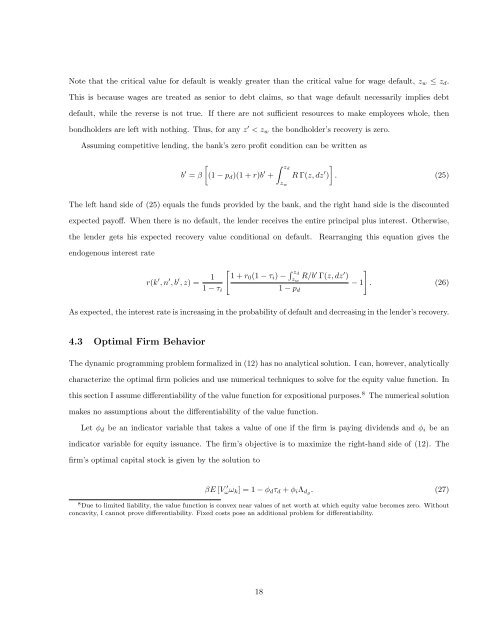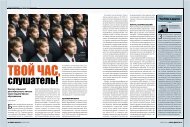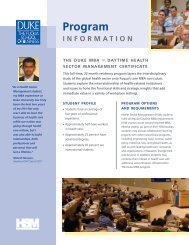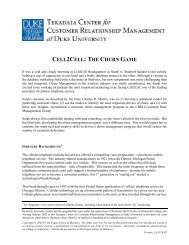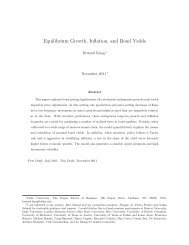A Structural Model of Human Capital and Leverage - Duke ...
A Structural Model of Human Capital and Leverage - Duke ...
A Structural Model of Human Capital and Leverage - Duke ...
Create successful ePaper yourself
Turn your PDF publications into a flip-book with our unique Google optimized e-Paper software.
Note that the critical value for default is weakly greater than the critical value for wage default, zw ≤ zd.<br />
This is because wages are treated as senior to debt claims, so that wage default necessarily implies debt<br />
default, while the reverse is not true. If there are not sufficient resources to make employees whole, then<br />
bondholders are left with nothing. Thus, for any z ′ < zw the bondholder’s recovery is zero.<br />
Assuming competitive lending, the bank’s zero pr<strong>of</strong>it condition can be written as<br />
b ′ �<br />
= β (1 − pd)(1 + r)b ′ � zd<br />
+<br />
zw<br />
R Γ(z, dz ′ �<br />
) . (25)<br />
The left h<strong>and</strong> side <strong>of</strong> (25) equals the funds provided by the bank, <strong>and</strong> the right h<strong>and</strong> side is the discounted<br />
expected pay<strong>of</strong>f. When there is no default, the lender receives the entire principal plus interest. Otherwise,<br />
the lender gets his expected recovery value conditional on default. Rearranging this equation gives the<br />
endogenous interest rate<br />
r(k ′ , n ′ , b ′ , z) = 1<br />
1 − τi<br />
�<br />
1 + r0(1 − τi) − � zd<br />
zw R/b′ Γ(z, dz ′ �<br />
)<br />
− 1 . (26)<br />
1 − pd<br />
As expected, the interest rate is increasing in the probability <strong>of</strong> default <strong>and</strong> decreasing in the lender’s recovery.<br />
4.3 Optimal Firm Behavior<br />
The dynamic programming problem formalized in (12) has no analytical solution. I can, however, analytically<br />
characterize the optimal firm policies <strong>and</strong> use numerical techniques to solve for the equity value function. In<br />
this section I assume differentiability <strong>of</strong> the value function for expositional purposes. 8 The numerical solution<br />
makes no assumptions about the differentiability <strong>of</strong> the value function.<br />
Let φd be an indicator variable that takes a value <strong>of</strong> one if the firm is paying dividends <strong>and</strong> φi be an<br />
indicator variable for equity issuance. The firm’s objective is to maximize the right-h<strong>and</strong> side <strong>of</strong> (12). The<br />
firm’s optimal capital stock is given by the solution to<br />
βE [V ′ ωωk] = 1 − φdτd + φiΛdg . (27)<br />
8 Due to limited liability, the value function is convex near values <strong>of</strong> net worth at which equity value becomes zero. Without<br />
concavity, I cannot prove differentiability. Fixed costs pose an additional problem for differentiability.<br />
18


